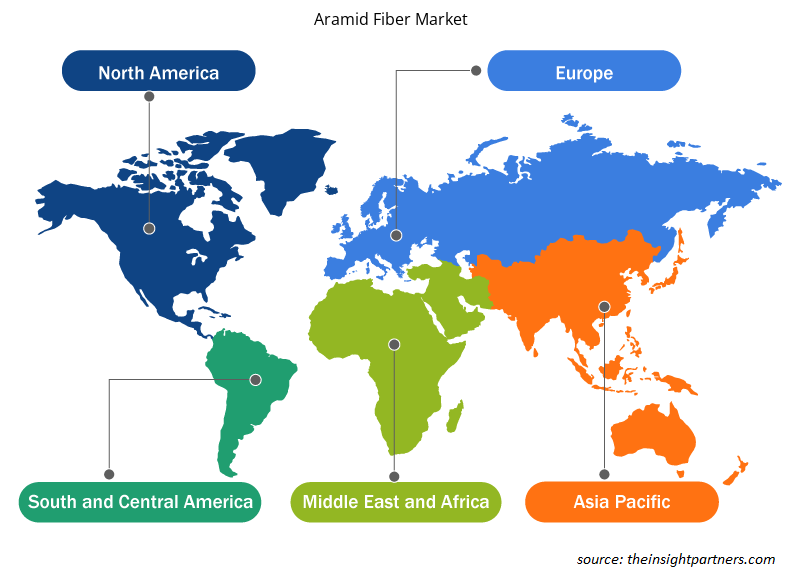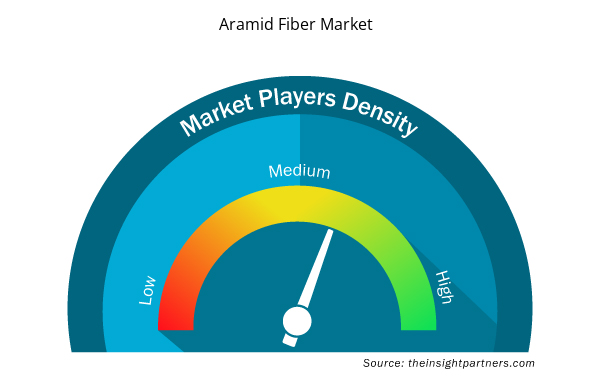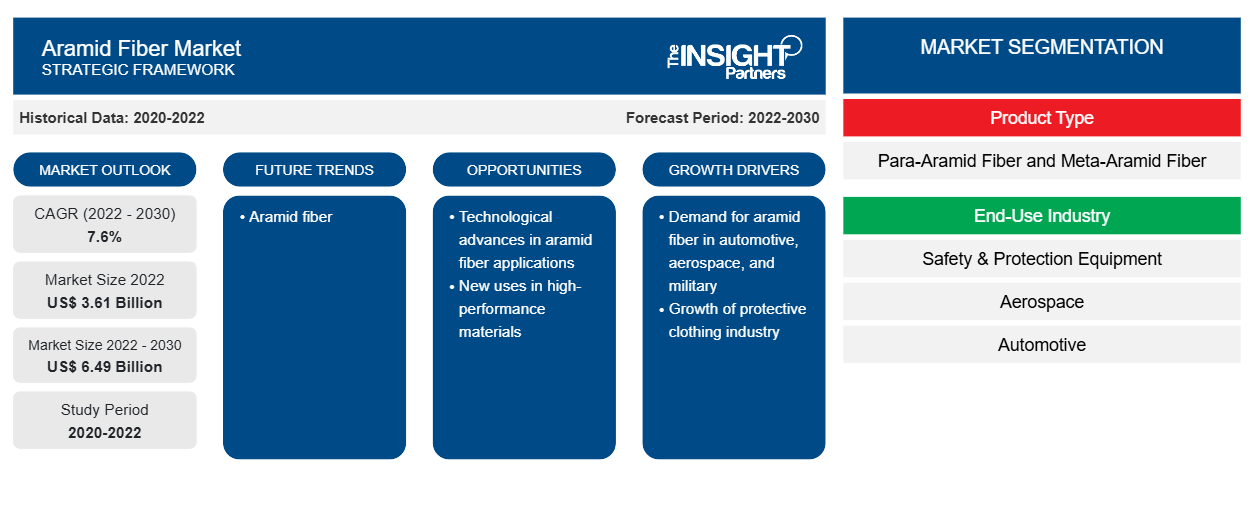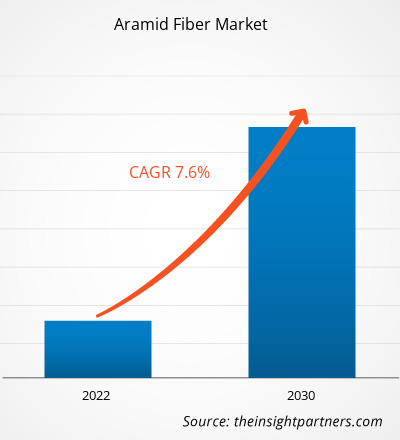[Informe de investigación] El tamaño del mercado de fibra de aramida se valoró en US$ 3.61 mil millones en 2022 y se espera que alcance los US$ 6.49 mil millones para 2030; se estima que registrará una CAGR del 7,6% de 2022 a 2030.
Perspectivas del mercado y opinión de analistas:
Las fibras de aramida, también conocidas como poliamidas aromáticas, son fibras sintéticas con una resistencia, resistencia al calor y durabilidad excepcionales. Son famosas por su alta resistencia a la tracción, que es cinco o seis veces mayor que la del acero, y por su naturaleza liviana, ya que pesan solo una quinta parte del acero. Estas propiedades notables hacen que estas fibras sean valiosas para una amplia gama de aplicaciones, en particular en industrias que exigen un alto rendimiento y seguridad. La estructura única de las fibras de aramida contribuye significativamente a sus propiedades excepcionales. Estas fibras consisten en largas cadenas de moléculas de poliamida, donde los enlaces amida están directamente unidos a anillos aromáticos. Esta disposición da como resultado una estructura rígida, similar a una varilla, que imparte una resistencia y rigidez notables a las fibras. Además, los anillos aromáticos brindan resistencia al calor y estabilidad inherentes, lo que permite que estas fibras soporten altas temperaturas sin una degradación significativa.
Factores impulsores del crecimiento y desafíos:
La creciente demanda de la industria automotriz ha sido una fuerza impulsora importante detrás de la expansión del mercado de fibra de aramida . La demanda de estas fibras ha aumentado exponencialmente a medida que los fabricantes de automóviles se centran cada vez más en producir vehículos más ligeros y de mayor eficiencia de combustible. La alta relación resistencia-peso de estas fibras, en particular las variantes de para-aramida, incluido el Kevlar, permite el desarrollo de componentes livianos sin comprometer la integridad estructural. En el sector automotriz, estas fibras se utilizan ampliamente en diversas aplicaciones, incluida la fabricación de neumáticos, frenos, pastillas y materiales compuestos. El refuerzo de estos componentes con estas fibras mejora su durabilidad y resistencia al desgaste, lo que contribuye a una vida útil más larga y un mejor rendimiento general. Además, estas fibras se utilizan en la producción de compuestos automotrices, proporcionando un equilibrio entre resistencia y peso crucial para lograr los objetivos de eficiencia de combustible. Por lo tanto, todos estos factores están impulsando la demanda de fibras de aramida en el sector automotriz.
Sin embargo, el mercado de las fibras de aramida enfrenta limitaciones en su crecimiento debido a la disponibilidad de sustitutos que ofrecen propiedades similares o alternativas. La fibra de carbono es uno de los principales sustitutos de estas fibras, que comparte algunas características con las fibras de aramida, incluidas propiedades de alta resistencia y ligereza. En ciertas aplicaciones, los fabricantes pueden optar por la fibra de carbono como alternativa, especialmente cuando buscan materiales con mayor rigidez o conductividad. Esta competencia de sustitutos plantea un desafío a la adopción generalizada de estas fibras, particularmente en industrias donde ambos materiales podrían cumplir potencialmente con las especificaciones requeridas.
Personalice este informe según sus necesidades
Obtendrá personalización en cualquier informe, sin cargo, incluidas partes de este informe o análisis a nivel de país, paquete de datos de Excel, así como también grandes ofertas y descuentos para empresas emergentes y universidades.
- Obtenga las principales tendencias clave del mercado de este informe.Esta muestra GRATUITA incluirá análisis de datos, desde tendencias del mercado hasta estimaciones y pronósticos.
Segmentación y alcance del informe:
El "Análisis del mercado mundial de fibra de aramida hasta 2030" es un estudio especializado y profundo que se centra principalmente en las tendencias del mercado y las oportunidades de crecimiento en todo el mundo. El informe tiene como objetivo proporcionar una descripción general del mercado con una segmentación detallada del mercado por tipo de producto e industria de uso final. El mercado ha experimentado un alto crecimiento en el pasado reciente y se espera que continúe con esta tendencia durante el período de pronóstico. El informe proporciona estadísticas clave sobre el consumo de fibra de aramida a nivel mundial. Además, el informe proporciona una evaluación cualitativa de varios factores que afectan el desempeño del mercado de fibra de aramida a nivel mundial. El informe también incluye un análisis integral de los principales actores del mercado y sus desarrollos estratégicos clave. También se incluyen varios análisis sobre la dinámica del mercado para ayudar a identificar los factores impulsores clave, las tendencias del mercado y las oportunidades lucrativas que, a su vez, ayudarían a identificar los principales bolsillos de ingresos.
El análisis del ecosistema y el análisis de las cinco fuerzas de Porter proporcionan una visión de 360 grados del mercado, que ayuda a comprender toda la cadena de suministro y varios factores que afectan el crecimiento del mercado global de fibra de aramida.
Análisis segmental:
Según el tipo de producto, el mercado se divide en fibra de para-aramida y fibra de meta-aramida. En términos de industria de uso final, el mercado se segmenta en equipos de seguridad y protección, aeroespacial, automotriz, electrónica y telecomunicaciones, entre otros. El segmento de equipos de seguridad y protección registró una importante participación de mercado de fibra de aramida en 2022. Las fibras de aramida, en particular las variantes de para-aramida como el Kevlar, son reconocidas por su excepcional resistencia, alto módulo y resistencia al impacto, lo que las hace ideales para aplicaciones donde la seguridad y la protección son primordiales. Esta fibra se usa ampliamente en la fabricación de chalecos y cascos balísticos. La resistencia balística inherente de estas fibras, junto con su naturaleza liviana, las convierte en una opción preferida para los chalecos antibalas. Las agencias militares y policiales de todo el mundo utilizan ampliamente equipos de protección a base de aramida para brindar al personal una protección eficaz contra amenazas balísticas sin comprometer la movilidad. Todos estos factores están impulsando el mercado de fibra de aramida para el segmento de equipos de seguridad y protección.
Análisis regional:
Según la geografía, el mercado de la fibra de aramida está segmentado en cinco regiones clave: América del Norte, Europa, Asia Pacífico, América del Sur y Central, y Oriente Medio y África. El mercado estuvo dominado por Asia Pacífico, que representó aproximadamente US$ 1.000 millones en 2022. La región abarca una amplia cantidad de oportunidades para el crecimiento del mercado. El aumento de las inversiones extranjeras directas también conduce al crecimiento económico en la región. Se prevé que el uso creciente de estas fibras en numerosas aplicaciones, incluidas las piezas de automoción, la electrónica y otras, aumente la demanda de fibra de aramida en Asia Pacífico.
Se espera que Europa registre una tasa de crecimiento anual compuesta (CAGR) de más del 8,0 % entre 2022 y 2030. Las fibras de aramida son fundamentales para la fabricación de componentes ligeros pero robustos en estructuras de aeronaves y sistemas de protección balística. Dado que Europa alberga a las principales empresas aeroespaciales y un importante sector de defensa, la demanda de fibras de aramida en estas industrias sigue aumentando. Además, se espera que América del Norte alcance alrededor de 1.700 millones de dólares en 2030.
Desarrollos industriales y oportunidades futuras:
A continuación se enumeran varias iniciativas adoptadas por los actores clave que operan en el mercado de fibra de aramida:
- En abril de 2023, DuPont de Nemours Inc. anunció el lanzamiento de la fibra de aramida Kevlar EXOTM. Kevlar EXO brindará una combinación de ligereza, flexibilidad y protección a partir de la fibra de aramida, siendo la protección de la vida el primero de muchos casos de uso.
Perspectivas regionales del mercado de fibra de aramida
Los analistas de Insight Partners explicaron en detalle las tendencias y los factores regionales que influyen en el mercado de fibra de aramida durante el período de pronóstico. Esta sección también analiza los segmentos y la geografía del mercado de fibra de aramida en América del Norte, Europa, Asia Pacífico, Oriente Medio y África, y América del Sur y Central.

- Obtenga datos regionales específicos para el mercado de fibra de aramida
Alcance del informe sobre el mercado de fibra de aramida
| Atributo del informe | Detalles |
|---|---|
| Tamaño del mercado en 2022 | US$ 3.61 mil millones |
| Tamaño del mercado en 2030 | 6.490 millones de dólares estadounidenses |
| CAGR global (2022-2030) | 7,6% |
| Datos históricos | 2020-2022 |
| Período de pronóstico | 2022-2030 |
| Segmentos cubiertos | Por tipo de producto
|
| Regiones y países cubiertos | América del norte
|
| Líderes del mercado y perfiles de empresas clave |
|
Densidad de actores del mercado: comprensión de su impacto en la dinámica empresarial
El mercado de fibra de aramida está creciendo rápidamente, impulsado por la creciente demanda de los usuarios finales debido a factores como la evolución de las preferencias de los consumidores, los avances tecnológicos y una mayor conciencia de los beneficios del producto. A medida que aumenta la demanda, las empresas amplían sus ofertas, innovan para satisfacer las necesidades de los consumidores y aprovechan las tendencias emergentes, lo que impulsa aún más el crecimiento del mercado.
La densidad de actores del mercado se refiere a la distribución de las empresas o firmas que operan dentro de un mercado o industria en particular. Indica cuántos competidores (actores del mercado) están presentes en un espacio de mercado determinado en relación con su tamaño o valor total de mercado.
Las principales empresas que operan en el mercado de fibra de aramida son:
- DuPont de Nemours Inc
- Teijin limitada
- Compañía de materiales avanzados Yantai Tayho
- Corporación Hyosung
- Industrias Toray Inc.
Descargo de responsabilidad : Las empresas enumeradas anteriormente no están clasificadas en ningún orden particular.

- Obtenga una descripción general de los principales actores clave del mercado de fibra de aramida
Impacto del COVID-19:
La pandemia de COVID-19 afectó negativamente a casi todas las industrias en varios países. Los confinamientos, las restricciones de viaje y los cierres de empresas en América del Norte, Europa, Asia Pacífico (APAC), América del Sur y Central, y Oriente Medio y África (MEA) obstaculizaron el crecimiento de varias industrias, incluida la industria química y de materiales. El cierre de las unidades de fabricación de las empresas de fibras de aramida perturbó las cadenas de suministro globales, las actividades de fabricación y los cronogramas de entrega. Varias empresas informaron retrasos en las entregas de productos y una caída en las ventas de sus productos en 2020. La mayoría de las instalaciones de fabricación industrial cerraron durante la pandemia, lo que disminuyó el consumo de estas fibras. Además, la pandemia de COVID-19 ha provocado fluctuaciones en los precios de la fibra de aramida. Sin embargo, varias industrias reanudaron sus operaciones después de que se resolvieron las limitaciones de suministro, lo que llevó a una reactivación del mercado de contenedores de plástico. Además, la creciente demanda de estas fibras por parte de la industria automotriz está promoviendo sustancialmente el crecimiento del mercado de la fibra de aramida.
Panorama competitivo y empresas clave:
DuPont de Nemours Inc, Teijin Limited, Yantai Tayho Advanced Materials Company, Hyosung Corporation, Toray Industries Inc, Kolon Industries, Huvis Corporation, China National Bluestar (Group) Co Ltd, Taekwang Industrial Co Ltd y Kermel SAS se encuentran entre los actores clave que operan en el mercado global de fibra de aramida. Los actores del mercado global se centran en proporcionar productos de alta calidad para satisfacer la demanda de los clientes.
- Análisis histórico (2 años), año base, pronóstico (7 años) con CAGR
- Análisis PEST y FODA
- Tamaño del mercado Valor/volumen: global, regional, nacional
- Industria y panorama competitivo
- Conjunto de datos de Excel



Report Coverage
Revenue forecast, Company Analysis, Industry landscape, Growth factors, and Trends

Segment Covered
This text is related
to segments covered.

Regional Scope
North America, Europe, Asia Pacific, Middle East & Africa, South & Central America

Country Scope
This text is related
to country scope.
Preguntas frecuentes
In 2022, Asia Pacific held the largest share of the global aramid fiber market. The region encompasses an ample number of opportunities for the growth of the market. Rising foreign direct investments also lead to economic growth in the region. The growing use of these fibers in numerous applications, including automotive parts, electronics, and others. All these factors led to the dominance of the Asia Pacific region in 2022.
A few players operating in the global aramid fiber market include DuPont de Nemours Inc, Teijin Limited, Yantai Tayho Advanced Materials Company, Hyosung Corporation, Toray Industries Inc, Kolon Industries, Huvis Corporation, China National Bluestar (Group) Co Ltd, Taekwang Industrial Co Ltd, and Kermel SAS.
The para-aramid fiber segment held the largest share in the global aramid fiber market in 2022. Para-aramids have high tensile strength (the highest stress that a material can withstand) and modulus behavior (the tendency of a material to deform when force is applied). The dry-jet, wet-spinning method is used to make these fibers, which results in fiber with completely extended liquid crystal chains generated along the fiber axis and a high degree of crystallinity, which boosts the fiber's strength. Their increasing use in security and safety applications drives the demand for para-aramid fibers. It is used in protective clothing such as bulletproof vests, helmets, and vehicle armor due to its ultra-high strength and rigid and highly oriented molecular structure. Thus, growing demand from the product type sectors led to the dominance of the para-aramid fiber segment in 2022.
Due to their excellent strength-to-weight ratio and heat resistance properties, aramid fibers play an essential role in composite materials and automotive and military applications. They can easily be integrated into textile applications in protective clothing, offer greater protection against heat, flame, and chemical products, and provide maximum comfort and absolute reliability. These fibers are a class of strong synthetic fibers commonly used in ballistic-rated body armor fabrics and composites. This reinforced fiber is lightweight and has a tensile strength five times stronger than the same weight, with high heat resistance and low cutting capacity. Growing demand from these end-used industries is driving the demand for aramid fiber from 2022 to 2030.
The automotive segment held the largest share of the global aramid fiber market in 2022. Aramid fibers are extensively used as a substitute for fiberglass and steel due to their lightweight, high tensile strength, and superior corrosion resistance in automotive hose manufacturing. Manufacturers in the automotive industry are constantly looking to stay competitive by bringing innovative products to market. Safety aspects, excellent performance, and the need for sustainability pressurizes the automotive industry to develop high-quality products.
Aramid fibers, particularly para-aramid variants such as Kevlar, are renowned for their exceptional strength, high modulus, and resistance to impact, making them ideal for applications where safety and protection are paramount. This fiber is extensively used in the manufacturing of ballistic vests and helmets. The inherent ballistic resistance of these fibers, coupled with their lightweight nature, makes them a preferred choice for body armor. Military and law enforcement agencies worldwide widely use aramid-based protective gear to provide personnel with effective protection against ballistic threats without compromising mobility. All these factors are expected to drive the safety & protection equipment from 2022 to 2030.
Trends and growth analysis reports related to Chemicals and Materials : READ MORE..
The List of Companies - Aramid Fiber Market
- DuPont de Nemours Inc
- Teijin Limited
- Yantai Tayho Advanced Materials Company
- Hyosung Corporation
- Toray Industries Inc
- Kolon Industries
- Huvis Corporation
- China National Bluestar (Group) Co Ltd
- Taekwang Industrial Co Ltd
- Kermel SAS
The Insight Partners performs research in 4 major stages: Data Collection & Secondary Research, Primary Research, Data Analysis and Data Triangulation & Final Review.
- Data Collection and Secondary Research:
As a market research and consulting firm operating from a decade, we have published and advised several client across the globe. First step for any study will start with an assessment of currently available data and insights from existing reports. Further, historical and current market information is collected from Investor Presentations, Annual Reports, SEC Filings, etc., and other information related to company’s performance and market positioning are gathered from Paid Databases (Factiva, Hoovers, and Reuters) and various other publications available in public domain.
Several associations trade associates, technical forums, institutes, societies and organization are accessed to gain technical as well as market related insights through their publications such as research papers, blogs and press releases related to the studies are referred to get cues about the market. Further, white papers, journals, magazines, and other news articles published in last 3 years are scrutinized and analyzed to understand the current market trends.
- Primary Research:
The primarily interview analysis comprise of data obtained from industry participants interview and answers to survey questions gathered by in-house primary team.
For primary research, interviews are conducted with industry experts/CEOs/Marketing Managers/VPs/Subject Matter Experts from both demand and supply side to get a 360-degree view of the market. The primary team conducts several interviews based on the complexity of the markets to understand the various market trends and dynamics which makes research more credible and precise.
A typical research interview fulfils the following functions:
- Provides first-hand information on the market size, market trends, growth trends, competitive landscape, and outlook
- Validates and strengthens in-house secondary research findings
- Develops the analysis team’s expertise and market understanding
Primary research involves email interactions and telephone interviews for each market, category, segment, and sub-segment across geographies. The participants who typically take part in such a process include, but are not limited to:
- Industry participants: VPs, business development managers, market intelligence managers and national sales managers
- Outside experts: Valuation experts, research analysts and key opinion leaders specializing in the electronics and semiconductor industry.
Below is the breakup of our primary respondents by company, designation, and region:

Once we receive the confirmation from primary research sources or primary respondents, we finalize the base year market estimation and forecast the data as per the macroeconomic and microeconomic factors assessed during data collection.
- Data Analysis:
Once data is validated through both secondary as well as primary respondents, we finalize the market estimations by hypothesis formulation and factor analysis at regional and country level.
- Macro-Economic Factor Analysis:
We analyse macroeconomic indicators such the gross domestic product (GDP), increase in the demand for goods and services across industries, technological advancement, regional economic growth, governmental policies, the influence of COVID-19, PEST analysis, and other aspects. This analysis aids in setting benchmarks for various nations/regions and approximating market splits. Additionally, the general trend of the aforementioned components aid in determining the market's development possibilities.
- Country Level Data:
Various factors that are especially aligned to the country are taken into account to determine the market size for a certain area and country, including the presence of vendors, such as headquarters and offices, the country's GDP, demand patterns, and industry growth. To comprehend the market dynamics for the nation, a number of growth variables, inhibitors, application areas, and current market trends are researched. The aforementioned elements aid in determining the country's overall market's growth potential.
- Company Profile:
The “Table of Contents” is formulated by listing and analyzing more than 25 - 30 companies operating in the market ecosystem across geographies. However, we profile only 10 companies as a standard practice in our syndicate reports. These 10 companies comprise leading, emerging, and regional players. Nonetheless, our analysis is not restricted to the 10 listed companies, we also analyze other companies present in the market to develop a holistic view and understand the prevailing trends. The “Company Profiles” section in the report covers key facts, business description, products & services, financial information, SWOT analysis, and key developments. The financial information presented is extracted from the annual reports and official documents of the publicly listed companies. Upon collecting the information for the sections of respective companies, we verify them via various primary sources and then compile the data in respective company profiles. The company level information helps us in deriving the base number as well as in forecasting the market size.
- Developing Base Number:
Aggregation of sales statistics (2020-2022) and macro-economic factor, and other secondary and primary research insights are utilized to arrive at base number and related market shares for 2022. The data gaps are identified in this step and relevant market data is analyzed, collected from paid primary interviews or databases. On finalizing the base year market size, forecasts are developed on the basis of macro-economic, industry and market growth factors and company level analysis.
- Data Triangulation and Final Review:
The market findings and base year market size calculations are validated from supply as well as demand side. Demand side validations are based on macro-economic factor analysis and benchmarks for respective regions and countries. In case of supply side validations, revenues of major companies are estimated (in case not available) based on industry benchmark, approximate number of employees, product portfolio, and primary interviews revenues are gathered. Further revenue from target product/service segment is assessed to avoid overshooting of market statistics. In case of heavy deviations between supply and demand side values, all thes steps are repeated to achieve synchronization.
We follow an iterative model, wherein we share our research findings with Subject Matter Experts (SME’s) and Key Opinion Leaders (KOLs) until consensus view of the market is not formulated – this model negates any drastic deviation in the opinions of experts. Only validated and universally acceptable research findings are quoted in our reports.
We have important check points that we use to validate our research findings – which we call – data triangulation, where we validate the information, we generate from secondary sources with primary interviews and then we re-validate with our internal data bases and Subject matter experts. This comprehensive model enables us to deliver high quality, reliable data in shortest possible time.


 Obtenga una muestra gratuita de este informe
Obtenga una muestra gratuita de este informe